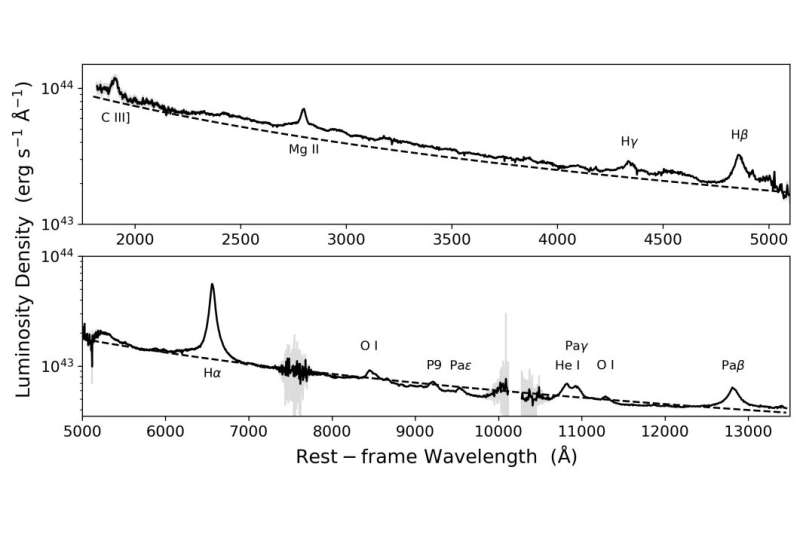June 16, 2022 report
New luminous quasar detected by astronomers

An international team of astronomers reports the detection of a new luminous quasi-stellar object, or quasar. The newly found object, designated SMSS J114447.77-430859.3 (or J1144 for short) turns out to be the most luminous quasar known over the last 9 billion years of cosmic history. The discovery was presented in a paper published June 9 on the arXiv pre-print repository.
Quasars are active galactic nuclei (AGN) of very high luminosity, emitting electromagnetic radiation observable in radio, infrared, visible, ultraviolet and X-ray wavelengths. They are among the brightest and most distant objects in the known universe, and serve as fundamental tools for numerous studies in astrophysics as well as cosmology. For instance, quasars have been used to investigate the large-scale structure of the universe and the era of reionization. They also improved our understanding of the dynamics of supermassive black holes and the intergalactic medium.
Recently, astronomers led by Christopher A. Onken of the Australian National University (ANU) in Canberra, Australia have performed a spectroscopic investigation of a bright, blue, point-like source selected from the SkyMapper Southern Survey Data Release 2 (SMSS DR2). The study, conducted mainly with the South African Astronomical Observatory (SAAO) 1.9-meter telescope and its SpUpNIC instrument (Spectrograph Upgrade: Newly Improved Cassegrain), found that this source, designated J1144, is a quasar at a redshift of 0.83.
According to the study, J1144 has a bolometric luminosity of about 470 quattuordecillion erg/s, which makes it the most luminous quasar of the last 9 billion years. It is also the optically brightest (unbeamed) quasar at a redshift greater than 0.4.
The astronomers estimate that the mass of the black hole in J1144 is approximately 2.6 billion solar masses. This value, together with the bolometric luminosity, yields an Eddington ratio at a level of 1.4 for this quasar.
It was noted that the high luminosity of J1144 suggests a large size of its broad line region (BLR). The research indicates that the size of the hydrogen-beta (Hβ) emitting region is about 1,200 light days. However, the angular size of the BLR is expected to be in excess of 100 microarcseconds.
Summing up the results, the authors of the paper explained how the properties of J1144 may be useful for further observations.
"Additional studies may make productive use of an exceptionally bright quasar like J1144 as a background source. For example, UV spectroscopy of J1144 may probe the Milky Way's circumgalactic medium," the researchers wrote in the paper.
The astronomers added that a spectroscopic campaign using the ANU 2.3m telescope has already identified about 80 new, bright quasars. Therefore, their new study is an important addition that brings us closer to complete the census of bright quasars.
More information: Christopher A. Onken et al, Discovery of the most luminous quasar of the last 9 Gyr. arXiv:2206.04204v1 [astro-ph.GA], arxiv.org/abs/2206.04204
© 2022 Science X Network




















